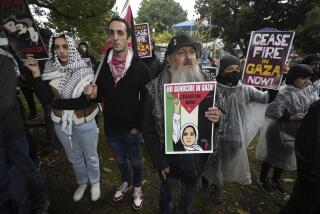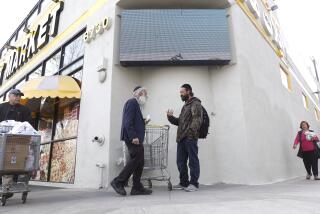Torah and hora
WHEN I became a bat mitzvah in 1986, I lamented my parents’ refusal to throw me the type of swanky shindig that I saw many of my friends enjoying -- no ice sculpture for me or my name in lights at a posh hotel. Instead, I suffered like Job as my father, a rabbi, made me recite both my Torah and Haftara portions before the congregation I grew up with and found my reward to be a small party at his university’s faculty lounge the next day. As I fought with my stepmother over my Laura Ashley dress (I was convinced it would look better with a Duran Duran T-shirt over it), I dreamed of my makeup more than the matriarchs.
Shockingly enough, I never thought of myself as shallow, and according to the books “Bar Mitzvah Disco” and “Thirteen and a Day,” it seems my lack of contemplative depth on the occasion of my being consecrated as a Jewish adult was all too typical. For some American Jews, the bar mitzvah (for boys) or bat mitzvah (for girls) has, over the years, lost its significance as the marker of religious adulthood and has become a kosher-style debutante ball where assimilationist and religious impulses clash. The results can be well-intentioned, sometimes tacky and often highly amusing.
For the generation that came of age in the ‘80s and ‘90s, the bar and bat mitzvah party reflected the anxieties and social aspirations of a great many Jewish Americans more than it did any particular religious transformation, and the pictures in “Bar Mitzvah Disco” prove it. Organized like a giant photo album, the book is as much an irony-laden testament to kitsch as it is to the premier adolescent institution of Jewish life. “Bar Mitzvah Disco” is an extension of a popular website where people were asked to post their most humiliating rite-of-passage pictures; the title sums up its humorous ambivalence.
What does the day on which Jewish children take on the commitments of adulthood have to do with a mirrored ball and Top 40 music? The two worlds are an uneasy and funny fit. From pictures of girls who clearly subscribed to the adage, “The higher the hair, the closer to God” to portraits of 13-year-old boys slow-dancing with girls at least a foot taller, the collected photos of assimilated American Jews dipping a toe into the religious can be quite funny and downright awful.
Some of the photographs, which were liberated from family dens across America, border on the bizarre. Food is offered from a “MattDonald’s” stand complete with golden arches at one party, a bar mitzvah boy is immortalized on a mock Playgirl cover with a headline reading “Ecstasy ... for Two!” at another and there are several break-dancing competitions led by Michael Jackson and Madonna impersonators. What are we to make of an event that makes a junior high schooler (who is arguably at the most awkward age on the planet) into a superstar for an evening?
No words can quite sum up this confused state as well as the book’s photograph of Asher Weinberg. Looking in the mirror during his bar mitzvah in 1981 on Long Island, he watches his sweet, chubby, adorably nerdy face contort in delight at his own reflection.
But as charming as these pictures are, they can make you wonder: Why are young Jews so attracted to the idea of mocking themselves? Could it be we’re just gifted with an excellent collective sense of humor, or is it possible that for some people who haven’t considered their religious identity since they were 13 that this is just an easy way to do so? Despite these questions, “Bar Mitzvah Disco” indisputably provides hipster credentials and a cringe-inducing trip down memory lane.
The book reads like a secret handshake of irony for history’s ultimate outsiders. It features ‘80s disco hits -- the staple of many a bar mitzvah dance floor -- as chapter titles and short essays the editors solicited from contributors such as novelist Jonathan Safran Foer (delighting in how he ruined his friend’s bat mitzvah by leading her to believe that he made out with her friend), comedian Sarah Silverman (who writes a funny ode to teenage lust), Los Angeles Times columnist Joel Stein (who laments his parents spending more money on his sister’s celebration than on his) and comedian Jordan Carlos, who wrote a poem about being the only black kid at the bar mitzvah: “ ... the halcyon year that was the sixth grade, / when I tried to fit a yarmulke on a high-top fade.”
Figuring out how to balance religious head coverings on Afros might be confusing, but figuring out what the modern bar mitzvah experience means seems to be no easier. Symbolically, it crystallizes the confusion of what religious identity means in today’s world. Is it a public celebration or a private ritual? Is the emphasis on personal meaning or community recognition?
In his book “Thirteen and a Day,” journalist Mark Oppenheimer offers a more serious look at the bar and bat mitzvah ritual in American life. He approaches the ceremony from the point of view of a nonreligious Jew who has not undergone the ritual himself and seeks to find out what this ritual means to his people.
“How they celebrate them, what those celebrations look like, and what they mean have become a problem for contemporary Judaism, with the power to pervert religion into neurosis, joy into anxiety,” he writes in his introduction. “Thirteen and a Day” offers a nuanced look at the modern-day incarnation of the ritual and all of its complications.
Oppenheimer finds both inspiring and depressing answers to what the ritual has become. Traveling from Alaska to Louisiana, he finds children and adults who genuinely see their first day of Jewish adulthood as a way to mark the kind of religious life they want to live and others who treat the day as a way to live out some sort of materialistic fantasy. Moving across the religious spectrum, from Reform to Orthodox, Oppenheimer also offers an interesting portrait of the people -- the tutor, the rabbi, the temple president -- behind the religious ceremony that shapes the experience of many Jewish Americans today.
Both books convey the message that, for many, the modern bar or bat mitzvah -- with one’s own themed party complete with DJ, ice sculpture and, oh yeah, a religious ceremony -- evolved from being a marker for Jewish children in which they would begin to participate in the congregation and were maybe greeted with a small reception after services into its modern-day bonanza in the late ‘60s. As the ‘70s progressed into the ‘90s, the bar mitzvah party seemed to embody everything both right and wrong with American Jewish culture -- the celebration of family and children alongside sometimes decidedly unreligious materialism.
While I wince looking back at how I behaved back then (and am now grateful to my parents for their low-key approach), apparently there are a lot of people wincing along with me. Now that Gen X and Y have had their say about their communal bonding embarrassment and love of the bar mitzvah, one can only wonder what the millennial generation will title its tome on the subject: “Bar Mitzvah Hip-Hop”? Oy. *
More to Read
Sign up for our Book Club newsletter
Get the latest news, events and more from the Los Angeles Times Book Club, and help us get L.A. reading and talking.
You may occasionally receive promotional content from the Los Angeles Times.









